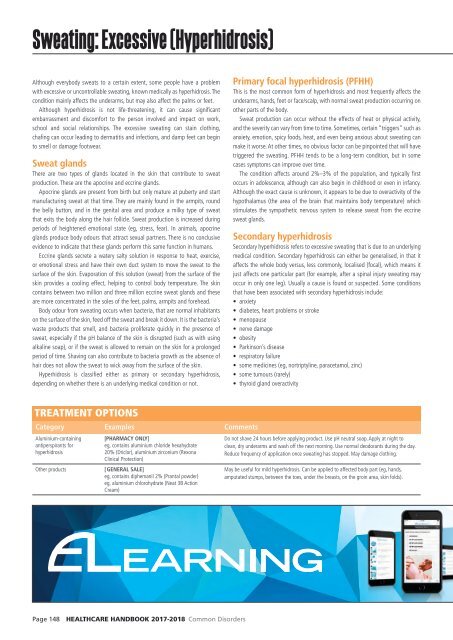2017 HCHB_digital
Create successful ePaper yourself
Turn your PDF publications into a flip-book with our unique Google optimized e-Paper software.
Sweating: Excessive (Hyperhidrosis)<br />
Although everybody sweats to a certain extent, some people have a problem<br />
with excessive or uncontrollable sweating, known medically as hyperhidrosis. The<br />
condition mainly affects the underarms, but may also affect the palms or feet.<br />
Although hyperhidrosis is not life-threatening, it can cause significant<br />
embarrassment and discomfort to the person involved and impact on work,<br />
school and social relationships. The excessive sweating can stain clothing,<br />
chafing can occur leading to dermatitis and infections, and damp feet can begin<br />
to smell or damage footwear.<br />
Sweat glands<br />
There are two types of glands located in the skin that contribute to sweat<br />
production. These are the apocrine and eccrine glands.<br />
Apocrine glands are present from birth but only mature at puberty and start<br />
manufacturing sweat at that time. They are mainly found in the armpits, round<br />
the belly button, and in the genital area and produce a milky type of sweat<br />
that exits the body along the hair follicle. Sweat production is increased during<br />
periods of heightened emotional state (eg, stress, fear). In animals, apocrine<br />
glands produce body odours that attract sexual partners. There is no conclusive<br />
evidence to indicate that these glands perform this same function in humans.<br />
Eccrine glands secrete a watery salty solution in response to heat, exercise,<br />
or emotional stress and have their own duct system to move the sweat to the<br />
surface of the skin. Evaporation of this solution (sweat) from the surface of the<br />
skin provides a cooling effect, helping to control body temperature. The skin<br />
contains between two million and three million eccrine sweat glands and these<br />
are more concentrated in the soles of the feet, palms, armpits and forehead.<br />
Body odour from sweating occurs when bacteria, that are normal inhabitants<br />
on the surface of the skin, feed off the sweat and break it down. It is the bacteria’s<br />
waste products that smell, and bacteria proliferate quickly in the presence of<br />
sweat, especially if the pH balance of the skin is disrupted (such as with using<br />
alkaline soap), or if the sweat is allowed to remain on the skin for a prolonged<br />
period of time. Shaving can also contribute to bacteria growth as the absence of<br />
hair does not allow the sweat to wick away from the surface of the skin.<br />
Hyperhidrosis is classified either as primary or secondary hyperhidrosis,<br />
depending on whether there is an underlying medical condition or not.<br />
Primary focal hyperhidrosis (PFHH)<br />
This is the most common form of hyperhidrosis and most frequently affects the<br />
underarms, hands, feet or face/scalp, with normal sweat production occurring on<br />
other parts of the body.<br />
Sweat production can occur without the effects of heat or physical activity,<br />
and the severity can vary from time to time. Sometimes, certain “triggers” such as<br />
anxiety, emotion, spicy foods, heat, and even being anxious about sweating can<br />
make it worse. At other times, no obvious factor can be pinpointed that will have<br />
triggered the sweating. PFHH tends to be a long-term condition, but in some<br />
cases symptoms can improve over time.<br />
The condition affects around 2%–3% of the population, and typically first<br />
occurs in adolescence, although can also begin in childhood or even in infancy.<br />
Although the exact cause is unknown, it appears to be due to overactivity of the<br />
hypothalamus (the area of the brain that maintains body temperature) which<br />
stimulates the sympathetic nervous system to release sweat from the eccrine<br />
sweat glands.<br />
Secondary hyperhidrosis<br />
Secondary hyperhidrosis refers to excessive sweating that is due to an underlying<br />
medical condition. Secondary hyperhidrosis can either be generalised, in that it<br />
affects the whole body versus, less commonly, localised (focal), which means it<br />
just affects one particular part (for example, after a spinal injury sweating may<br />
occur in only one leg). Usually a cause is found or suspected. Some conditions<br />
that have been associated with secondary hyperhidrosis include:<br />
• anxiety<br />
• diabetes, heart problems or stroke<br />
• menopause<br />
• nerve damage<br />
• obesity<br />
• Parkinson’s disease<br />
• respiratory failure<br />
• some medicines (eg, nortriptyline, paracetamol, zinc)<br />
• some tumours (rarely)<br />
• thyroid gland overactivity<br />
TREATMENT OPTIONS<br />
Category Examples Comments<br />
Aluminium-containing<br />
antiperspirants for<br />
hyperhidrosis<br />
Other products<br />
[PHARMACY ONLY]<br />
eg, contains aluminium chloride hexahydrate<br />
20% (Driclor), aluminium zirconium (Rexona<br />
Clinical Protection)<br />
[GENERAL SALE]<br />
eg, contains diphemanil 2% (Prantal powder)<br />
eg, aluminium chlorohydrate (Neat 3B Action<br />
Cream)<br />
Do not shave 24 hours before applying product. Use pH neutral soap. Apply at night to<br />
clean, dry underarms and wash off the next morning. Use normal deodorants during the day.<br />
Reduce frequency of application once sweating has stopped. May damage clothing.<br />
May be useful for mild hyperhidrosis. Can be applied to affected body part (eg, hands,<br />
amputated stumps, between the toes, under the breasts, on the groin area, skin folds).<br />
Page 148 HEALTHCARE HANDBOOK <strong>2017</strong>-2018 Common Disorders



